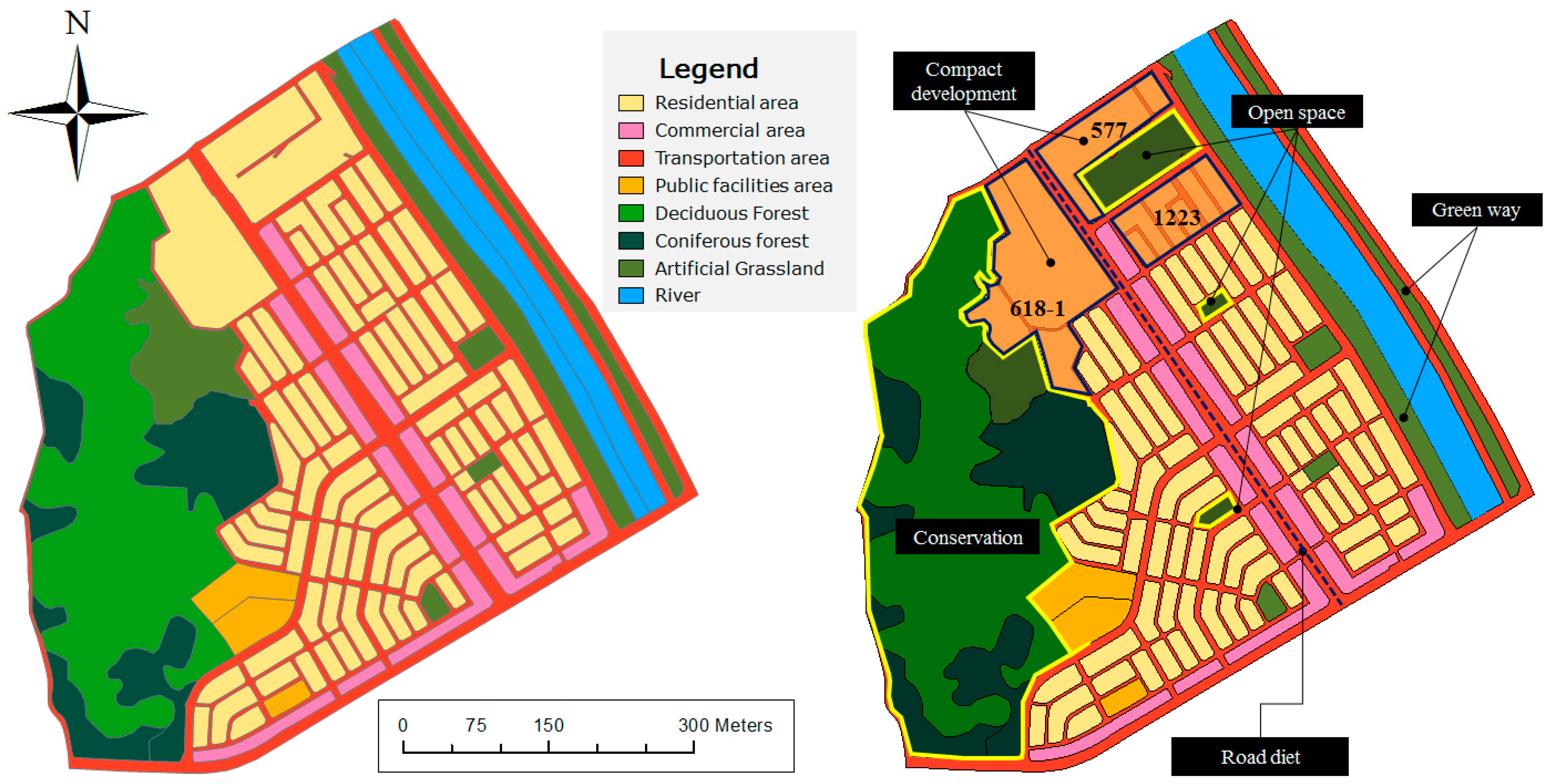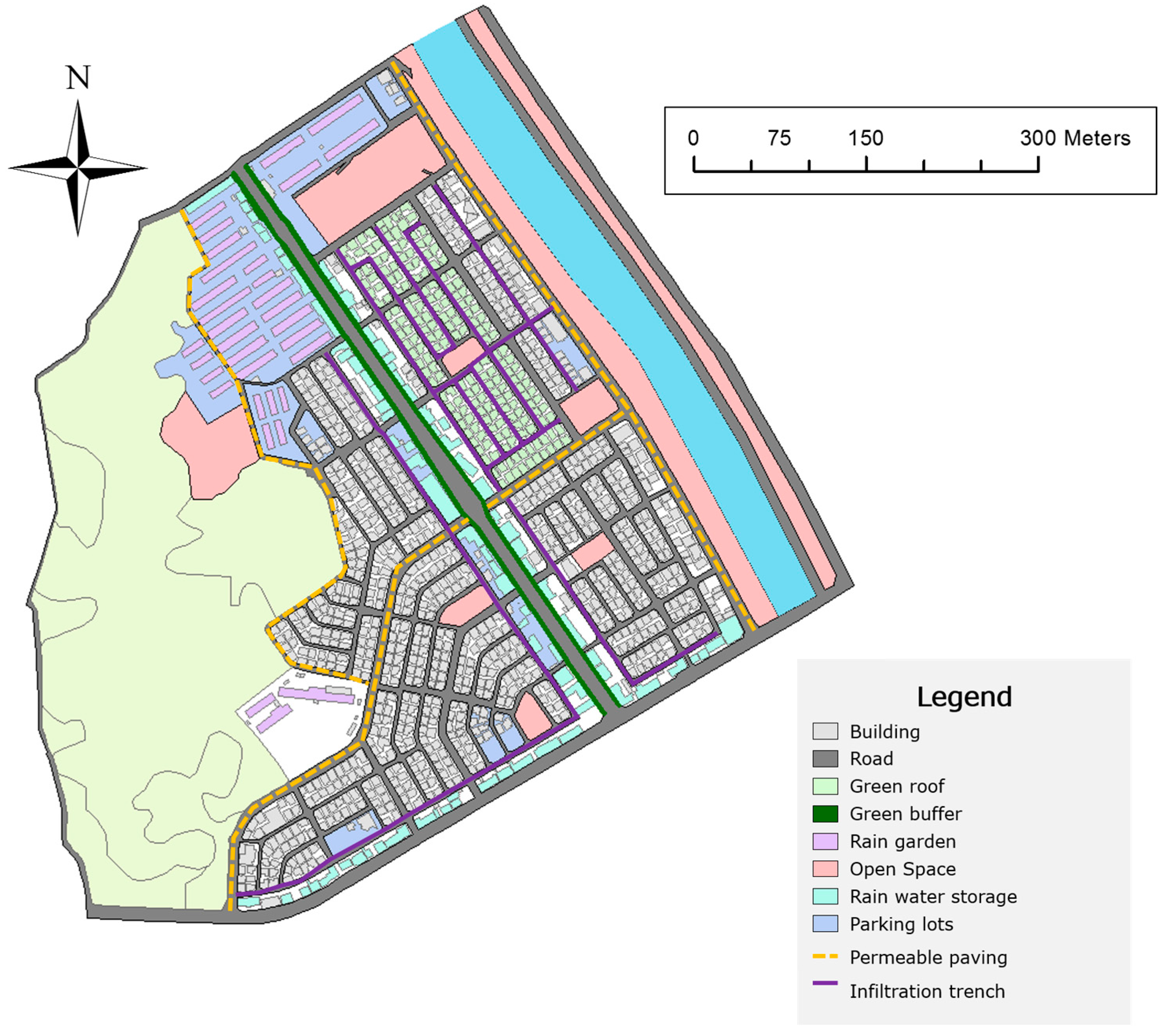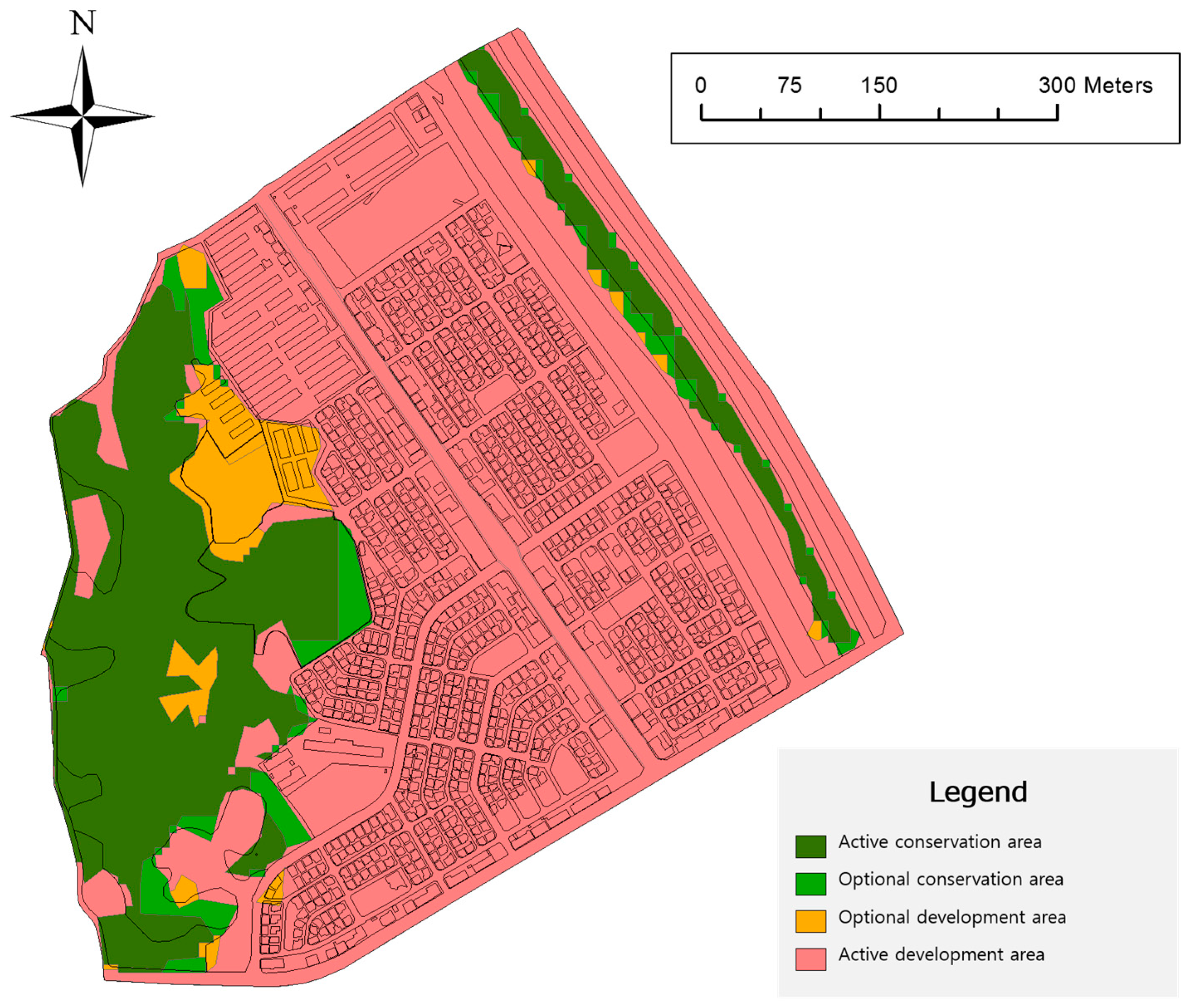4.2. Status Analysis
The study site had an region with a mild slope of about 0–2.0 degrees, which accounted for 76.8% of the entire area, and the forested region contained slopes of steeper grades (27.9–30 degrees). Land-use units consisted of forests (34.67%), residences (35.62%), roads (20.55%), river (3.97%), and other (5.19%). According to the Korean Water Environment Information System, the water quality of the site was seriously degraded in 1994 (Korean Water Environment Information System (Source:
http://water.nier.go.kr)) but the pollution level has been gradually decreasing since then. In 2015, BOD was measured at 1.6 mg/L, chemical oxygen demand (COD) at 3.4 mg/L, and suspended solids at 5 mg/L. Drainage gates were installed at final water discharge points. The catchment area was 0.47 km
2 and the invert of the drainage gate elevation level (EL) was 39.09 m. The built-up urban area was lowland and the residential and commercial areas were concentrated. The buildings were mainly low-rise structures of four or less floors and there was no open space. The roads and streets were covered mainly with impermeable paving materials such as asphalt and sidewalk blocks.
LID-related proposals in the study area included comprehensive plans for storm and flood damage and an open space plan. LID-related policies included an environmental impact assessment program, a land suitability assessment program, a total water pollution program, and a disaster vulnerability assessment program. A rainwater management master plan and a disaster prevention plan were yet to be designed at the time of this study. Because the site had been designated as a water pollution management area, the total pollution caused by urban development was limited to a certain degree. A LID-related municipal ordinance was not in place. According to the 2012 Storm and Flood Damage Reduction Plan of Cheongju City, the site and its vicinity have been designated as a flood risk area.
4.5. Plans for Each Sector
The non-structural techniques applied in the site plan are summarized as follows:
The plan was to construct a common residential area in the northern part of the land area allotted for residential use. The area at the address 618-1 was 14,673 m2 and could house nine dongs (districts) and 400 households. The area at the address 577 was 19,166 m2 and could house four dongs and 400 households. The area of land allotted for multi-family houses of four or fewer stories at the address 1223 was 17,219 m2 was switched to a common residential area and then a highly-concentrated development plan was designed. Buildings constructed in the common residential area should have a building coverage ratio of 35% or less, a floor-area ratio of 250% or less, and have 15 floors or less. The high flood risk area was not developed.
Considering of the role of business service functions in the biotope and highly concentrated development, 5.8% of the total project area of 56,079 m2 was assigned as semi-residential use.
In the entire green project area of 248,332 m2, it was decided that a total of 206,105 m2 was not to be developed. Rather, it was classified as a sensitive area with broadleaf forest, coniferous forest, mixed forest, and marsh. It was decided that a greenway would be installed along the edge of the common residence area and riverside to prevent the influx of nonpoint source pollutants into the river and to connect the space.
Parking lots and off-street parking spots were set to be planned. The required allotment of 0.6% of total area (61,183 m2 in this case) as set by the parking lot law was added to the plans. Because of the designed green buffer, the area of the main road was reduced.
According to the existing open space plan, 29,506 m2 of park area was set to be designed for the area.
Table 5 presents the land-use planning indicators that apply to the non-structural techniques.
Figure 4 presents the land cover map of the initially planned and the plan.
The structural techniques applied to the site plan are as follows:
All the parking lots inside the site had permeable paving and beds of vegetation. Permeable paving was not applied to the main roads with considerable traffic.
Infiltration trenches and dry wells were installed along the roads and were arranged in a linear form based on the river bearing the flood risk and the forest as a possible water catchment.
Considering the site area, rain retention facilities were installed at a commercial arcade where sufficient amounts of rain could be amassed.
Green roofs were applied to the buildings that had a sufficient load capacity without the risk of urban flooding.
Parks were designed to include vegetation beds, water courses, and permeable paving.
Roadway noise prevention facilities and green networks were formed around the roadsides of the south-north arterial roads, which reflected the previously designed green buffer plan (5 m in width).
Table 6 shows the quantified area of each planned LID facility and the basis of calculation according to zoning.
Figure 5 presents the plan for the LID facility application according to zoning districts.
After completing the draft of the site plan, it was assessed for its capacity to meet the benefit targets generated in the initial phases of the plan. The assessment results are summarized in
Table 7. In the case of reducing nonpoint source pollution, the volume of nonpoint source pollutant generated in the site (
Table 7) after application of LID-DP was found to be T-N 1435 kg/year, T-P 70 kg/year, and BOD 1496 kg/year. These figures indicate that the reduction was greater than the planned target (
Table 7), with an additional T-N, T-P, and BOD reduction of 584 kg/year, 75 kg/year, and 2404 kg/year, respectively. Compared with the conventional urban development method (
Table 7), the volume of nonpoint source pollutant generated in the site after LID-DP (
Table 7) showed a maximum (f-100%) reduction of T-N, T-P, and BOD at 37%, 56%, and 72%, respectively (
Table 7).
In the case of rainfall runoff reduction, the rainfall runoff generated in the site following the establishment of LID-DP was 14,072,800 mm/year of infiltration and 275,898,290 mm/year of surface runoff. In other words, the infiltration increased by 203,180 mm/year (1.4%) compared to target (
Table 8) and the surface runoff decreased by 2,620,551 mm/year (0.9%). Additionally, LID-DP created a maximum 289% increase of infiltration and 40% decrease of surface runoff compared to the conventional urban development method (
Table 8).
For conservation of the natural environment, the degree of target success was obtained by carrying out spatial overlapping (matching) of the planned land cover map (
Figure 4) and land use matrix (
Figure 6). According to the LID-DP, the area conserved was 363,373 m
2 with an active conservation area of 198,717 m
2. This area covered 150,000 m
2 of protected green space with high ecological quality and 48,717 m
2 of additional conservation area. The optional conservation area also had secured green space at a ratio of 0.94. This is a reduced figure as part of the green space was developed into multi-family housing. Additionally, the ratio of the area for active development was 0.79 and that for the optional development 0.41. This is because the areas set for active development and optional development were not entirely developed, but were instead changed into parks and conservation areas.
In this study, LID-DP has shown that LID in the study area would provide a benefit of reduced T-N, T-P and BOD (113%, 193%, and 199%, respectively), reduced effects of infiltration volume (102%) and surface runoff (101%) and a 132% conservation rate of the natural environment.
Several non-structural techniques were applied in the planning process and it was demonstrated that no target required the implementation of structural techniques. Regarding the nonpoint source pollution, the target to be met through structural techniques (b − a,
Table 7) after the application of non-structural techniques was T-N 16 (kg/year), T-P –13 (kg/year), and BOD 146 (kg/year). Regarding the rainfall runoff, (b′ − a′,
Table 8), the infiltration was 126,710 (mm/year) and surface runoff was −2,499,908 (mm/year). These figures are quite insignificant considering the basic unit of the LID.
Further, if the entire developable area was developed, the volume of the nonpoint source pollution generated compared to the target, [(f-100%)/(a),
Table 7], increased by 140%, 117%, and 176% for T-N, T-P, and BOD, respectively. The volume of rainfall runoff generated compared to the target, [(f′-100%)/(a′),
Table 8], increased the surface runoff by 164% and decreased infiltration by 26%.
The land-use matrix, which assesses the conservation of natural environment, not only identified areas for conservation and development, but also offered development directions and standards for the LID depending on the land characteristics in the redesign stage of the site plan draft. This study prioritized active conservation in the areas classified as first-grade for their high ecological value. Here, the water cycle function was maintained for the non-structural techniques. The second-grade areas were set to either be conserved or developed depending on the plans and development objectives. The third- and fourth-grade areas were set to be developed first if necessary. Here, the decline of water cycle function could be minimized or improved with structural and non-structural techniques.
The overall analysis of the study site results showed that the LID-DP in this study sufficiently met set objectives and targets, and the plan was rational based on the direction of development. There is great development pressure on the green space of the study site because the area available for development covers 248,332 m2 (25.6% of the total area), except for the river. Nonetheless, a plan was designed through LID-DP that minimizes pollution and environmental impact following development.











